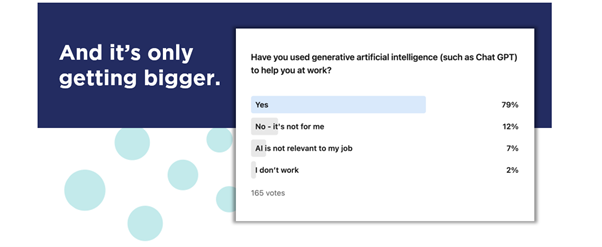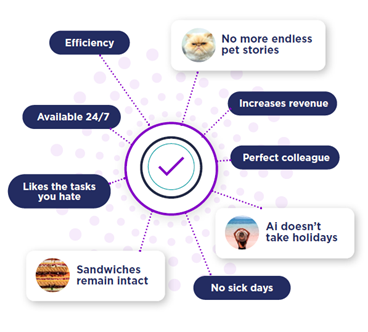Marketing meets AI: what’s hype, what’s real, and what’s next
27 Nov 2025 | by Katie Harvard
We weigh up the risks and rewards of AI, and how marketers can maximise its potential
Artificial intelligence isn’t just the stuff of sci-fi anymore. It’s running in the background of your favourite apps, recommending your next purchase, and quietly optimising campaigns while you sleep. In marketing, AI is no longer a “nice-to-have” – it’s a driving force. It speeds up processes, boosts efficiency, and delivers those hyper-personalised experiences customers now expect.

According to Forbes, the UK AI market was worth more than £72 billion in 2024 and projected to grow to a jaw-dropping £1 trillion by 2035
Around one in six UK organisations are embracing AI – with 68% of large companies, 33% of medium-sized companies, and 15% of small companies incorporating at least one AI technology.
What does that mean if you’re in marketing? Your daily interactions with AI are about to skyrocket 🚀
But here’s the million-dollar question: Why does integrating AI into our marketing strategies make us uneasy? Is it a game-changing opportunity or looming threat? Let’s break it down.
What exactly is AI in marketing?
At its core, AI in marketing is about using smart algorithms to analyse data, automate work, personalise customer interactions, and generate content. The goal? Work smarter, not harder.
Generative AI (GenAI) can whip up text, images, and videos in seconds. And marketers are paying attention. In fact, 78% of CMOs plan to use GenAI to fuel new business models within the next 12–18 months.
AI is powered by two main technologies. Both are powerful tools, but they serve different purposes:
1. Machine Learning (ML)
ML has been around for decades, quietly doing the heavy lifting behind customer segmentation, predictive analytics, and eerily spot-on product recommendations. It’s the number-crunching genius of the pair, quietly powering the analytics that marketers have come to rely on. ML looks at existing data and tells you what it means.
2. Generative AI (GenAI)
GenAI takes what it’s learned from existing data and creates something new from it. It’s the creative whiz kid that generates something new based on the data and information it has been trained on. That ‘something new’ could be a blog, an image, music, or a personalised email.
The result? Content that sounds surprisingly human. But here’s the caveat. It’s not inventing entirely new ideas; it’s remixing and reinterpreting what already exists. Which means fact-checking is a must.
How AI stacks up against traditional marketing
AI isn’t here to replace strategic thinking. Traditional marketing leans on gut instinct and past performance. AI takes that, adds real-time analytics, and predicts what’s next.
Here’s what’s changing:
- Goodbye repetitive tasks, hello streamlined workflows with process automation
- Data-driven decisions help to predict what works best before you even hit “publish”
- Hyper-personalisation ensures you deliver the right message to the right person at the right time
Why marketers are loving AI
💜 Massive efficiency gains
AI takes over repetitive jobs like sending emails or tweaking ad targeting, freeing you up to focus on big-picture strategy.
💜 Laser-focused personalisation
Predictive analytics can tell you the “next best offer” for each customer – making your campaigns way more relevant.
💜 Smarter decision-making
AI processes more data in seconds than you could in a week, spotting trends you might have missed.
7 real-world AI marketing wins 🏆
- Predicting purchasing behaviour means that you spend smarter by knowing who’s ready to buy
- Customer Lifetime Value (CLV) forecasting helps you spot your most profitable customers early
- Content creation and optimisation powered by AI tools draft, edit, and refine in seconds – just don’t skip the human review
- Chatbots and customer service provide 24/7 answers, personalised help, and happier customers
- AI-powered behavioural modelling processes mountains of messy data at ridiculous speed, spotting patterns we’d never notice, and refining predictions as information comes in
- AI makes personalisation faster, smarter, and more precise by collecting, unifying and stitching together data in real time – at a scale no human team could manage
- Customer segmentation uses AI-powered clustering for deeper insight into your audience
The flip side: what are the challenges?
Around 59% of Brits have concerns about the use of artificial intelligence with ‘dependence on AI and loss of human skills’ ranking at the top of the list. If we lean too heavily on AI, do we risk dulling human originality?
Because GenAI is unable to generate anything that is entirely new, there is a view that AI-generated content often lacks originality and creativity. A recent study found that 50% of consumers can tell the difference between human-generated and AI-generated content, and as a result felt less engaged.
High quantity but low quality? As long as training data is high-quality and unbiased, AI is fast, impartial, and accurate. This is true of ML; however, GenAI, though powerful, has a tendency to make things up. This is known as a hallucination.
Open-source AI systems, especially when handling lots of data, can be vulnerable to data breaches. Privacy laws such as GDPR and the new AI Act set boundaries, but the responsibility to use data ethically is still on you.
How Apteco keeps AI safe and smart
James Alty, Founder and MD of Apteco, puts it best:

That means:
- Maximum data security – always encrypted
- No customer data used to train external models
- The Apteco engine generates content and prevents hallucinations
- Total transparency about what AI can – and can’t – do
So… will AI turn me into a marketing guru, or put me out of a job?
AI is already impacting marketing roles and will continue to do so. And it’s going to keep reshaping marketing whether we’re ready or not. The winners will be those who blend AI’s speed and scale with human judgment and creativity.
Repetitive, low-value tasks such as writing copy for 200 variations of the same ad, pulling together reports, and manually segmenting lists is the kind of work AI can do faster, cheaper, and at scale.
Instead of worrying about AI taking our jobs, we can take advantage by:
- Using AI as a power tool to move faster
- Focusing on strategy, creativity, brand positioning, and human insight
- Learning to interpret AI outputs critically, not blindly accepting them
- Understanding data and automation workflows enough to ‘Captain the ship’
❤️Love it or hate it, AI is here to stay
By 2025, global data volume is expected to hit 181 zettabytes (yes, that is as huge as it sounds). The complexity of marketing will only grow, and AI will be essential to keep up.
The real challenge isn’t the tech, it’s how we use it. The sweet spot is where AI’s capabilities meet human insight. Get that balance right, and AI isn’t just another marketing tool; it’s your competitive advantage.
Download our free eguide The good, the bad and the ugly: marketing AI explained to learn more about how AI affects marketers and how Apteco is committed to developing AI in our software in a safe, constructive, and practical manner.

